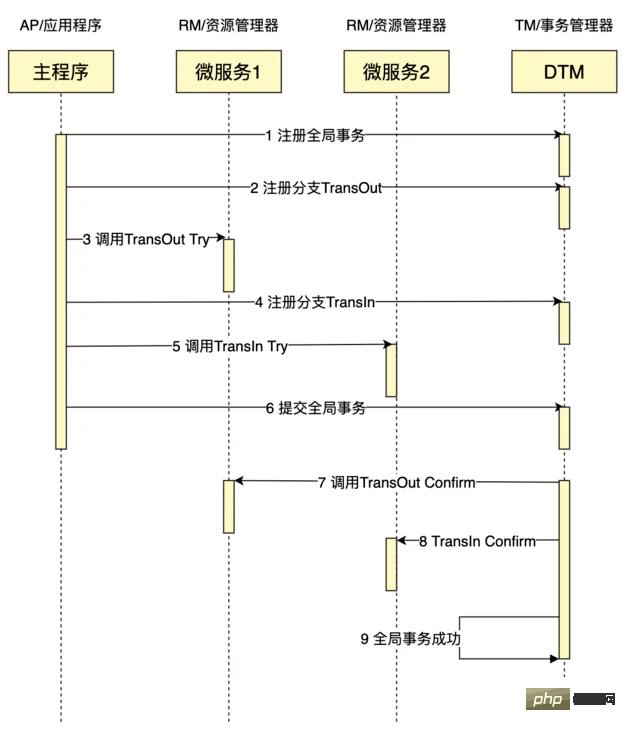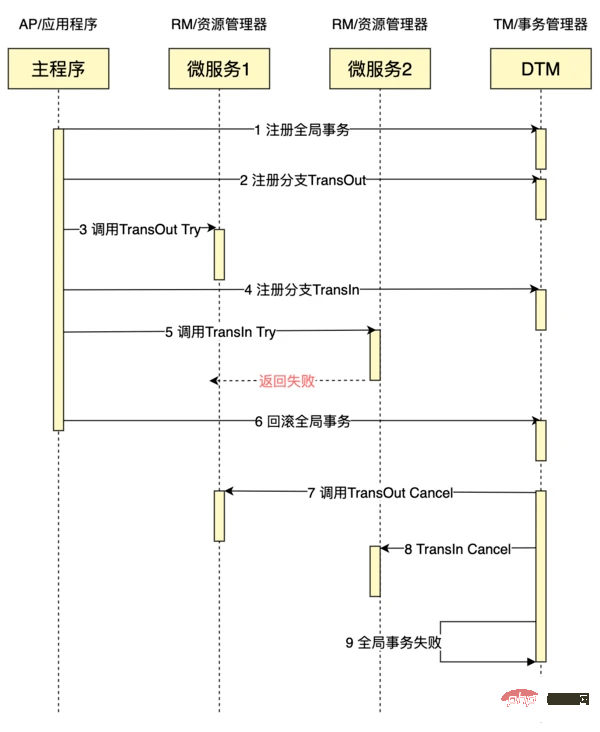 Backend Development
Backend Development
 PHP Tutorial
PHP Tutorial
 Teach you step by step how to use PHP to complete a distributed transaction TCC
Teach you step by step how to use PHP to complete a distributed transaction TCC
Teach you step by step how to use PHP to complete a distributed transaction TCC
What is TCC? TCC is the abbreviation of Try, Confirm, and Cancel. It was first proposed by Pat Helland in a paper titled "Life beyond Distributed Transactions: an Apostate's Opinion" published in 2007. .
TCC composition
TCC is divided into 3 phases
- Try phase: try to execute, complete all business checks (consistency), Reserve necessary business resources (quasi-isolation)
- Confirm stage: If the Try of all branches is successful, go to the Confirm stage. Confirm actually executes the business, does not perform any business checks, and only uses the business resources reserved in the Try stage.
- Cancel stage: If one of the Trys of all branches fails, it goes to the Cancel stage. Cancel releases the business resources reserved in the Try phase.
In TCC distributed transactions, there are three roles, which are the same as classic XA distributed transactions:
- AP/application, initiates global transactions and defines global transactions Which transaction branches are included?
- RM/Resource Manager is responsible for the management of various resources of branch transactions.
- TM/Transaction Manager is responsible for coordinating the correct execution of global transactions, including the execution of Confirm and Cancel. , and handle network exceptions
If we want to conduct a business similar to inter-bank transfers, the transfer out (TransOut) and the transfer in (TransIn) are in different microservices, and a successfully completed The typical sequence diagram of a TCC transaction is as follows:

##TCC Practice
Now we will carry out the specific development of a TCC transactionThe open source framework currently available for TCC is mainly Java language, represented by seata. Our example uses nodejs, and the distributed transaction framework used is dtm, which supports distributed transactions very elegantly. Let’s explain the composition of TCC in detailLet’s write specific Try/Confirm/Cancel processing functions$vega->handleFunc('/api/TransOutTry', function (Mix\Vega\Context $ctx) {
var_dump('TransOutTry', $ctx->request->getQueryParams(), $ctx->request->getParsedBody());
$ctx->JSON(200, ['result' => 'SUCCESS']);})->methods('POST');$vega->handleFunc('/api/TransOutConfirm', function (Mix\Vega\Context $ctx) {
var_dump('TransOutConfirm', $ctx->request->getQueryParams(), $ctx->request->getParsedBody());
$ctx->JSON(200, ['result' => 'SUCCESS']);})->methods('POST');$vega->handleFunc('/api/TransOutCancel', function (Mix\Vega\Context $ctx) {
var_dump('TransOutCancel', $ctx->request->getQueryParams(), $ctx->request->getParsedBody());
$ctx->JSON(200, ['result' => 'SUCCESS']);})->methods('POST');$vega->handleFunc('/api/TransInTry', function (Mix\Vega\Context $ctx) {
var_dump('TransInTry', $ctx->request->getQueryParams(), $ctx->request->getParsedBody());
$ctx->JSON(200, ['result' => 'SUCCESS']);})->methods('POST');$vega->handleFunc('/api/TransInConfirm', function (Mix\Vega\Context $ctx) {
var_dump('TransInConfirm', $ctx->request->getQueryParams(), $ctx->request->getParsedBody());
$ctx->JSON(200, ['result' => 'SUCCESS']);})->methods('POST');$vega->handleFunc('/api/TransInCancel', function (Mix\Vega\Context $ctx) {
var_dump('TransInCancel', $ctx->request->getQueryParams(), $ctx->request->getParsedBody());
$ctx->JSON(200, ['result' => 'SUCCESS']);})->methods('POST'); Dtmcli\tccGlobalTransaction($dtm, function ($tcc) use ($svc) {
/** @var Dtmcli\Tcc $tcc */
$req = ['amount' => 30];
$tcc->callBranch($req, $svc . '/TransOutTry', $svc . '/TransOutConfirm', $svc . '/TransOutCancel');
$tcc->callBranch($req, $svc . '/TransInTry', $svc . '/TransInConfirm', $svc . '/TransInCancel');
});# 部署启动dtm# 需要docker版本18以上git clone https://github.com/yedf/dtmcd dtm docker-compose up# 另起一个命令行https://github.com/yedf/dtmcli-php-sample.gitcd dtmcli-php-sample composer installphp demo.php start
TCC's Rollback
What happens if the bank finds that user 2’s account is abnormal and the return fails when the amount is being transferred to user 2? We can simulate this situation by letting TransIn return failure$vega->handleFunc('/api/TransInTry', function (Mix\Vega\Context $ctx) {
var_dump('TransInTry', $ctx->request->getQueryParams(), $ctx->request->getParsedBody());
$ctx->JSON(200, ['result' => 'FAILURE']);})->methods('POST');
Summary
In this article, we introduced the theoretical knowledge of TCC, and also gave a complete process of writing a TCC transaction through an example, covering Normal and successful completion, as well as successful rollback. I believe that readers have a deep understanding of TCC through this article. For more comprehensive knowledge about distributed transactions, please refer to "The Seven Most Classic Solutions for Distributed Transactions"
The examples used in this article are excerpted from yedf /dtm (https://github.com/yedf/dtm), which supports multiple transaction modes: TCC, SAGA, XA, cross-language support for transaction messages, and has supported customers in golang, python, Java, Teach you step by step how to use Teach you step by step how to use PHP to complete a distributed transaction TCC to complete a distributed transaction TCC, nodejs and other languages. terminal, refer to each language SDK (https://dtm.pub/summary/code.html#go). Provides sub-transaction barrier function to elegantly solve problems such as idempotence, suspension, and null compensation. After reading this article, you are welcome to visit the github.com/yedf/dtm project and give a star to support it!The above is the detailed content of Teach you step by step how to use PHP to complete a distributed transaction TCC. For more information, please follow other related articles on the PHP Chinese website!

Hot AI Tools

Undresser.AI Undress
AI-powered app for creating realistic nude photos

AI Clothes Remover
Online AI tool for removing clothes from photos.

Undress AI Tool
Undress images for free

Clothoff.io
AI clothes remover

Video Face Swap
Swap faces in any video effortlessly with our completely free AI face swap tool!

Hot Article

Hot Tools

Notepad++7.3.1
Easy-to-use and free code editor

SublimeText3 Chinese version
Chinese version, very easy to use

Zend Studio 13.0.1
Powerful PHP integrated development environment

Dreamweaver CS6
Visual web development tools

SublimeText3 Mac version
God-level code editing software (SublimeText3)

Hot Topics
 1666
1666
 14
14
 1426
1426
 52
52
 1328
1328
 25
25
 1273
1273
 29
29
 1254
1254
 24
24
 PHP and Python: Comparing Two Popular Programming Languages
Apr 14, 2025 am 12:13 AM
PHP and Python: Comparing Two Popular Programming Languages
Apr 14, 2025 am 12:13 AM
PHP and Python each have their own advantages, and choose according to project requirements. 1.PHP is suitable for web development, especially for rapid development and maintenance of websites. 2. Python is suitable for data science, machine learning and artificial intelligence, with concise syntax and suitable for beginners.
 PHP: A Key Language for Web Development
Apr 13, 2025 am 12:08 AM
PHP: A Key Language for Web Development
Apr 13, 2025 am 12:08 AM
PHP is a scripting language widely used on the server side, especially suitable for web development. 1.PHP can embed HTML, process HTTP requests and responses, and supports a variety of databases. 2.PHP is used to generate dynamic web content, process form data, access databases, etc., with strong community support and open source resources. 3. PHP is an interpreted language, and the execution process includes lexical analysis, grammatical analysis, compilation and execution. 4.PHP can be combined with MySQL for advanced applications such as user registration systems. 5. When debugging PHP, you can use functions such as error_reporting() and var_dump(). 6. Optimize PHP code to use caching mechanisms, optimize database queries and use built-in functions. 7
 PHP in Action: Real-World Examples and Applications
Apr 14, 2025 am 12:19 AM
PHP in Action: Real-World Examples and Applications
Apr 14, 2025 am 12:19 AM
PHP is widely used in e-commerce, content management systems and API development. 1) E-commerce: used for shopping cart function and payment processing. 2) Content management system: used for dynamic content generation and user management. 3) API development: used for RESTful API development and API security. Through performance optimization and best practices, the efficiency and maintainability of PHP applications are improved.
 PHP vs. Python: Understanding the Differences
Apr 11, 2025 am 12:15 AM
PHP vs. Python: Understanding the Differences
Apr 11, 2025 am 12:15 AM
PHP and Python each have their own advantages, and the choice should be based on project requirements. 1.PHP is suitable for web development, with simple syntax and high execution efficiency. 2. Python is suitable for data science and machine learning, with concise syntax and rich libraries.
 The Enduring Relevance of PHP: Is It Still Alive?
Apr 14, 2025 am 12:12 AM
The Enduring Relevance of PHP: Is It Still Alive?
Apr 14, 2025 am 12:12 AM
PHP is still dynamic and still occupies an important position in the field of modern programming. 1) PHP's simplicity and powerful community support make it widely used in web development; 2) Its flexibility and stability make it outstanding in handling web forms, database operations and file processing; 3) PHP is constantly evolving and optimizing, suitable for beginners and experienced developers.
 PHP vs. Other Languages: A Comparison
Apr 13, 2025 am 12:19 AM
PHP vs. Other Languages: A Comparison
Apr 13, 2025 am 12:19 AM
PHP is suitable for web development, especially in rapid development and processing dynamic content, but is not good at data science and enterprise-level applications. Compared with Python, PHP has more advantages in web development, but is not as good as Python in the field of data science; compared with Java, PHP performs worse in enterprise-level applications, but is more flexible in web development; compared with JavaScript, PHP is more concise in back-end development, but is not as good as JavaScript in front-end development.
 PHP and Python: Different Paradigms Explained
Apr 18, 2025 am 12:26 AM
PHP and Python: Different Paradigms Explained
Apr 18, 2025 am 12:26 AM
PHP is mainly procedural programming, but also supports object-oriented programming (OOP); Python supports a variety of paradigms, including OOP, functional and procedural programming. PHP is suitable for web development, and Python is suitable for a variety of applications such as data analysis and machine learning.
 PHP and Python: Code Examples and Comparison
Apr 15, 2025 am 12:07 AM
PHP and Python: Code Examples and Comparison
Apr 15, 2025 am 12:07 AM
PHP and Python have their own advantages and disadvantages, and the choice depends on project needs and personal preferences. 1.PHP is suitable for rapid development and maintenance of large-scale web applications. 2. Python dominates the field of data science and machine learning.



